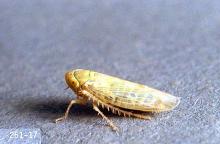Circullifer tenellus
Pest description and crop damage Light yellow-green to gray-brown wedge-shaped body about 0.125 inch long. These readily crawl and jump as nymphs or jump and fly as adults. They are most important as a vector of curly top virus; they are seldom numerous enough to cause feeding injury through sap sucking. Not all leafhoppers found in sugar beets are the true beet leafhopper.
Scouting and thresholds No formal economic thresholds exist for beet leafhopper insecticide treatment decisions.
Management-cultural control
Manage curly top by planting approved resistant varieties rather than solely attempting to kill the highly mobile, winged adult. Protection of plants early during the season is most important; later during the season, age-related resistance can increase the plant's tolerance to curly top virus. Hot, dry spring weather will accelerate drying of non-cultivated plants on which beet leafhoppers overwinter and cause them to move to crops earlier during the season, increasing risk.
Management-biological control
Little is known about biological control of the beet leafhopper; some parasitoid wasps have been observed in Idaho, but at low levels. See Table 3 for commercially formulated biological products.
Management-chemical control.
Consider insecticide seed treatment (Table 1) in high-risk areas. Post-emergence treatments (Tables 2-3) may be used instead of or to supplement at-plant treatments, but application timing would have to coincide with movement of beet leafhoppers into fields. Extensive research in Idaho has demonstrated highest efficacy with group 4A and 3A products.


